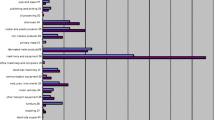Abstract
Many different theories that have attempted to explain why smaller entrepreneurial firms exist. Surprisingly, very little empirical work has tested the obvious questions, such as: Are small firm’s price-takers in highly competitive markets? Who do they compete against? What if they try to raise prices? Does innovation offer niche market protection? Using a large UK data set our key findings are that less than 5% of entrepreneurial firms operate in markets where they effectively have no competition and a quarter of all small firms would lose at least a third of their sales if they raised prices by 10%.
Similar content being viewed by others
References
Acs, Z. J., & Audretsch, D. B. (1987). Innovation, market structure, and firm size. The Review of Economics and Statistics, 69, 567–574.
Bain, J. S. (1951). Relation of profit rate to industry concentration: American manufacturing, 1936–1940. The Quarterly Journal of Economics, 65(3), 293–324.
Bain, J. S. (1956). Barriers to new competition, their character and consequences in manufacturing industries (No. HB771 B23).
Baran, P. A. (1966). Monopoly capital. New York: NYU Press.
Baumol, W. J., Bailey, E. E., & Willig, R. D. (1977). Weak invisible hand theorems on the sustainability of multiproduct natural monopoly. The American Economic Review, 67(3), 350–365.
Bradburd, R. M., & Ross, D. R. (1989). Can small firms find and defend strategic niches? A test of the Porter hypothesis. The Review of Economics and Statistics, 71, 258–262.
Brush, C. G., Edelman, L. F., & Manolova, T. (2015). The impact of resources on small firm internationalization. Journal of Small Business Strategy, 13(1), 1–17.
Chamberlin, E. H. (1937). Monopolistic or imperfect competition? The Quarterly Journal of Economics, 51(4), 557–580.
Conyon, M., & Machin, S. (1991). The determination of profit margins in UK manufacturing. The Journal of Industrial Economics, 39, 369–382.
Covin, J. G., & Slevin, D. P. (1989). Strategic management of small firms in hostile and benign environments. Strategic Management Journal, 10(1), 75–87.
Cowling, M. (2003). Productivity and corporate governance in smaller firms. Small Business Economics, 20(4), 335–344.
Cowling, K., & Waterson, M. (1976). Price-cost margins and market structure. Economica, 43(171), 267–274.
Dodge, H. R., Fullerton, S., & Robbins, J. E. (1994). Stage of the organizational life cycle and competition as mediators of problem perception for small businesses. Strategic Management Journal, 15(2), 121–134.
Fama, E. F., & Laffer, A. B. (1972). The number of firms and competition. The American Economic Review, 62(4), 670–674.
Hotelling, H. (1929). Stability in competition. The Economic Journal, 39(153), 41–57.
Lechner, C., & Gudmundsson, S. V. (2014). Entrepreneurial orientation, firm strategy and small firm performance. International Small Business Journal, 32(1), 36–60.
Machlup, F. (1952). The economics of sellers’ competition: Model analysis of sellers’ conduct (No. HB201 M285).
Niman, N. B. (1991). The entrepreneurial function in the theory of the firm. Scottish Journal of Political Economy, 38(2), 162–176.
Panzar, J. C. (1980). Regulation, deregulation, and economic efficiency: The case of the CAB. The American Economic Review, 70(2), 311–315.
Papadogonas, T., & Droucopoulos, V. (2015). Do small firms breathe heavily down the necks of their larger brethren? An empirical examination of the theory of strategic niches. South-Eastern Europe Journal of Economics, 2(1), 59–65.
Pelham, A. M., & Wilson, D. T. (1995). A longitudinal study of the impact of market structure, firm structure, strategy, and market orientation culture on dimensions of small-firm performance. Journal of the Academy of Marketing Science, 24(1), 27–43.
Porter, M. (1980). Industry and competitive advantage. New York: Free Press.
Posner, R. A. (1969). Natural monopoly and its regulation: A reply. Stanford Law Review, 22, 540.
Reid, G. C. (1993). Small Business Enterprise: An economic analysis. London: Routledge.
Robinson, J. (1934). What is perfect competition? The Quarterly Journal of Economics, 49(1), 104–120.
Robinson, J. (1953). The production function and the theory of capital. The Review of Economic Studies, 21(2), 81–106.
Salop, S. C. (1979). Monopolistic competition with outside goods. The Bell Journal of Economics, 10, 141–156.
Stigler, G. J. (1957). Perfect competition, historically contemplated. Journal of Political Economy, 65(1), 1–17.
Stigler, G. J. (1964). A theory of oligopoly. Journal of Political Economy, 72(1), 44–61.
Sweezy, P. M. (1939). Demand under conditions of oligopoly. Journal of Political Economy, 47(4), 568–573.
Author information
Authors and Affiliations
Corresponding author
Additional information
Publisher's Note
Springer Nature remains neutral with regard to jurisdictional claims in published maps and institutional affiliations.
Appendix 1: Variable Descriptive Statistics
Appendix 1: Variable Descriptive Statistics
Mean | SD | Low | High | |
|---|---|---|---|---|
Firm characteristics | ||||
Size class | ||||
Micro | 64.58 | |||
Small | 28.83 | |||
Medium | 6.05 | |||
Large | 0.54 | |||
100.0 | ||||
Firm age | 4.12 | 6.09 | 0 | 208 |
High-Tech | 30.31 | 0 | 1 | |
Innovation | ||||
None | 71.98 | |||
Incremental | 10.48 | |||
Radical | 17.54 | |||
100.0 | ||||
Labour productivity £s | 96,252.74 | 166,977.20 | 5714.29 | 330,000.00 |
Industry | ||||
Primary—manufacturing | 19.15 | |||
Construction | 5.58 | |||
Services | 75.27 | |||
100.0 | ||||
Entrepreneurial characteristics | ||||
Board size | 2.17 | 3.95 | 1 | 135 |
NED | 15.00 | 0 | 1 | |
Years business experience | ||||
None | 4.57 | |||
< 1 year | 2.05 | |||
1–3 years | 13.52 | |||
4-6 years | 18.43 | |||
7–9 years | 10.38 | |||
10–15 years | 19.25 | |||
> 15 years | 31.81 | |||
100.0 | ||||
Spatial markets | ||||
Local | 54.01 | |||
Regional | 14.21 | |||
National | 26.44 | |||
EU | 2.32 | |||
World | 3.02 | |||
100.0 |
Rights and permissions
About this article
Cite this article
Cowling, M., Nadeem, S.P. Entrepreneurial Firms: With Whom Do They Compete, and Where?. Rev Ind Organ 57, 559–577 (2020). https://doi.org/10.1007/s11151-020-09782-y
Published:
Issue Date:
DOI: https://doi.org/10.1007/s11151-020-09782-y




